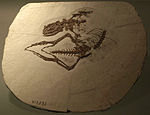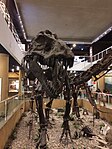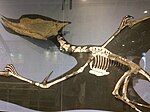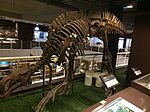Paleozoological Museum of China
 | |
 | |
Former name | Shu-hua Museum of Paleoanthropology, Museum of Vertebrate Paleontology |
|---|---|
| Established | 1929 |
| Location | 142 Xi-Zhi-Men-Wai Street, Beijing 100044, China |
| Type | Paleontology Museum |
| Director | Wang Yuan |
| Website | www |
The Paleozoological Museum of China (PMC; Chinese: 中国古动物馆) is a museum in Beijing, China. The same building also houses the Institute of Vertebrate Paleontology and Paleoanthropology of the Chinese Academy of Sciences. The museum contains exhibition halls with specimens aimed at the public, while the rest of the building is used for research purposes.[1]
Building
The main building consists of three floors, with the first floor displaying a number of fish and amphibian fossils, along with many
First Floor


The first floor of the museum contains a space for temporary exhibitions, the gift shop, a theater, and the exhibition space for a sub-museum of the Institute of Vertebrate Paleontology and Paleoanthropology, called the Shu-hua Museum of Paleoanthropology. It also contains the first floor of the main exhibition area, belonging to the other sub-museum of the IVPP, the Museum of Vertebrate Paleontology. The exhibition belonging to the Shu-hua Museum details the origins of man in China. Multiple casts of the skulls of early hominidae, which were discovered in Zhoukoudian, are displayed. A bronze bust of Peking Man is also on display. A small diorama of Homo erectus making fire is installed in a glass case.
Museum of Vertebrate Paleontology

The first floor of the exhibition area focuses on fish, amphibians, and Mesozoic reptiles. The centerpiece of the floor is a large installation displaying mounts of
Collection
The collection is significant as it contains many holotypes that were used in scientific journals to describe a number of ancient extinct lines of creatures unique to China. It has an active research facility, and its personnel include the famed Chinese
Gallery
-
A specimen of Confuciusornis sanctus on display at the museum.
-
A specimen of Paralycoptera wui on display at the museum.
-
Skull of Shansisuchus on display at the museum.
-
A specimen of Parakannemeyeria youngi on display at the museum.
-
Fossil specimen of Yixianornis Grabaui on display at the museum.
-
A mounted specimen of Juxia Sharamurenense on display at the museum.
-
A specimen of Dalinghosaurus longidigitus, on display at the museum.
-
Tsintaosaurus skeleton.
-
Platybelodon skull.
-
Huayangosaurus skull.
-
Homotherium skull.
-
Peking Man skull (replica).
-
The holotype of Microraptor on display at the museum.
-
A mounted cast of Tyrannosaurus specimen RTMP 81.6.1(Black Beauty), on the first floor of the museum.
-
A composite fossil which generated much controversy in 1999, informally named "Archaeoraptor", displayed on the second floor of the museum.
-
The holotype specimen of Lufengosaurus, the first fossil found in China, mounted at the museum.
-
The holotype of Dsungaripterus displayed on the second floor.
-
A mount of Probactrosaurus on the second floor.
-
Rhinotitan mount on the third floor.
-
An Archaeornithomimus from Inner Mongolia mounted on the second floor.
See also
References
- ^ http://english.cas.ac.cn/eng2003/dmk01a/pdf/11/Institute%20of%20Vertebrate%20Paleontology%20and%20Paleoanthropology.pdf[permanent dead link] Institute of Vertebrate Paleontology and Paleoanthropology, last visited July 10, 2008
- ^ http://www.china.org.cn/english/travel/164852.htm Paleozoological Museum of China, last visited July 9, 2008
- ^ "Chinese Academy of Sciences". Archived from the original on 2008-02-15. Retrieved 2008-07-11. A Comprehensive Study on the Vertebrates of the Jehol Biota in Western Liaoning Province, last visited July 10, 2008
- ^ "Museums of Beijing: Paleozoological Museum of China - Koryo Tours". koryogroup.com. 25 February 2021. Retrieved 2022-01-16.




















